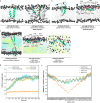Hairpin protein partitioning from the ER to lipid droplets involves major structural rearrangements
- PMID: 38802378
- PMCID: PMC11130287
- DOI: 10.1038/s41467-024-48843-8
Hairpin protein partitioning from the ER to lipid droplets involves major structural rearrangements
Abstract
Lipid droplet (LD) function relies on proteins partitioning between the endoplasmic reticulum (ER) phospholipid bilayer and the LD monolayer membrane to control cellular adaptation to metabolic changes. It has been proposed that these hairpin proteins integrate into both membranes in a similar monotopic topology, enabling their passive lateral diffusion during LD emergence at the ER. Here, we combine biochemical solvent-accessibility assays, electron paramagnetic resonance spectroscopy and intra-molecular crosslinking experiments with molecular dynamics simulations, and determine distinct intramembrane positionings of the ER/LD protein UBXD8 in ER bilayer and LD monolayer membranes. UBXD8 is deeply inserted into the ER bilayer with a V-shaped topology and adopts an open-shallow conformation in the LD monolayer. Major structural rearrangements are required to enable ER-to-LD partitioning. Free energy calculations suggest that such structural transition is unlikely spontaneous, indicating that ER-to-LD protein partitioning relies on more complex mechanisms than anticipated and providing regulatory means for this trans-organelle protein trafficking.
© 2024. The Author(s).
Conflict of interest statement
The authors declare no competing interests.
Figures






References
MeSH terms
Substances
Grants and funding
- CRC1027 project C9/Deutsche Forschungsgemeinschaft (German Research Foundation)
- INST 256/535-1/Deutsche Forschungsgemeinschaft (German Research Foundation)
- CRC 1027 project B7/Deutsche Forschungsgemeinschaft (German Research Foundation)
- INST 256/539-1/Deutsche Forschungsgemeinschaft (German Research Foundation)
LinkOut - more resources
Full Text Sources
Research Materials

